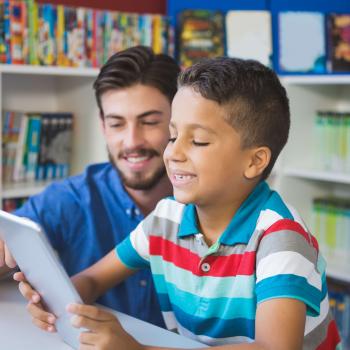Research Building Blocks: Skim, Scan, and Scroll

- Preview |
- Standards |
- Resources & Preparation |
- Instructional Plan |
- Related Resources |
- Comments
Overview
Children are naturally curious—they want to know "how" and "why." Teaching research skills can help students find answers for themselves. "Skim, Scan, and Scroll," taken from a research skills unit, is a step towards students completing a written research report. Here, students learn to read informational text, looking for supporting details. After the skills of skimming and scanning printed and electronic texts are modeled by the teacher, students practice the skills on their own.
From Theory to Practice
Teaching the process and application of research should be an ongoing part of all school curricula. It is important that research components are taught all through the year, beginning on the first day of school. Dreher et al. explain that "[S]tudents need to learn creative and multifaceted approaches to research and inquiry. The ability to identify good topics, to gather information, and to evaluate, assemble, and interpret findings from among the many general and specialized information sources now available to them is one of the most vital skills that students can acquire" (39). In her article "Rethinking Research," Eileen A. Simmons agrees: "We can't expect students to produce outstanding research papers unless we teach them strategies for gathering information, analyzing, synthesizing, and evaluating that information through critical thinking." (115)
Further Reading
Common Core Standards
This resource has been aligned to the Common Core State Standards for states in which they have been adopted. If a state does not appear in the drop-down, CCSS alignments are forthcoming.
State Standards
This lesson has been aligned to standards in the following states. If a state does not appear in the drop-down, standard alignments are not currently available for that state.
NCTE/IRA National Standards for the English Language Arts
- 1. Students read a wide range of print and nonprint texts to build an understanding of texts, of themselves, and of the cultures of the United States and the world; to acquire new information; to respond to the needs and demands of society and the workplace; and for personal fulfillment. Among these texts are fiction and nonfiction, classic and contemporary works.
- 3. Students apply a wide range of strategies to comprehend, interpret, evaluate, and appreciate texts. They draw on their prior experience, their interactions with other readers and writers, their knowledge of word meaning and of other texts, their word identification strategies, and their understanding of textual features (e.g., sound-letter correspondence, sentence structure, context, graphics).
- 4. Students adjust their use of spoken, written, and visual language (e.g., conventions, style, vocabulary) to communicate effectively with a variety of audiences and for different purposes.
- 5. Students employ a wide range of strategies as they write and use different writing process elements appropriately to communicate with different audiences for a variety of purposes.
- 6. Students apply knowledge of language structure, language conventions (e.g., spelling and punctuation), media techniques, figurative language, and genre to create, critique, and discuss print and nonprint texts.
- 7. Students conduct research on issues and interests by generating ideas and questions, and by posing problems. They gather, evaluate, and synthesize data from a variety of sources (e.g., print and nonprint texts, artifacts, people) to communicate their discoveries in ways that suit their purpose and audience.
- 8. Students use a variety of technological and information resources (e.g., libraries, databases, computer networks, video) to gather and synthesize information and to create and communicate knowledge.
- 11. Students participate as knowledgeable, reflective, creative, and critical members of a variety of literacy communities.
- 12. Students use spoken, written, and visual language to accomplish their own purposes (e.g., for learning, enjoyment, persuasion, and the exchange of information).
Materials and Technology
Internet access
Printouts
Preparation
- Review the following definitions with students:
- Skim: To read quickly for main ideas or supporting details in a text
- Scan: To move the eyes quickly over a text to find a specific point or points that answer a question or questions
- Skim: To read quickly for main ideas or supporting details in a text
- Print Activity Form #1 and Activity Form #2
Student Objectives
Students will
- use a variety of sources (e.g., media center, classroom resources, available technology) to locate information.
- use text aids (e.g., table of contents, glossary, captions, chapter headings, index) to locate information.
- use text structure (e.g., sequential order, chronological order, problem/solution) to determine most important information.
- apply appropriate reading strategies to fiction and nonfiction texts within and across content areas.
- use key words to identify relevant information. Discriminate between relevant and irrelevant information, and make generalizations based on relevant information from expository text.
- distinguish between main ideas and supporting details.
- organize and synthesize information.
Instruction & Activities
- Create a question that would arise from the unit your students are studying. Then, using the class text, model how to find a supporting detail in a paragraph that answers your question. Follow this by having the students generate a question of their own.
- Begin to "find" the answer by turning through all the pages in the book.
- Students will probably protest, telling you that there are better ways to find the answer. Generate a list of their responses.
- Talk about the skill of skimming, using the definition provided in the Preparation section.
- Seek the answer again, this time skimming to find it.
- Have the students complete Activity #1.
- Follow up the activity by having the students generate a short list of questions they have on a topic the class is studying.
- Discuss the skill of scanning, using the definition provided in the Preparation section.
- Model the scanning process while finding a few of the answers to their questions.
- Then have the students complete Activity #2.
- After skimming and scanning print sources, the students are ready to look at electronic sources. With an LCD projector, show an example of an online source. Discuss what characteristics of the site make it easy or difficult to read. Point out things such as headers, colored print, links, etc. A good site to try would be an online encyclopedia such as Encyclopedia.com.
- Have the students scroll through an entry, skimming and scanning for information that ties into what they've been studying in their print texts.
Extensions
Student Assessment / Reflections
As this is only one step in teaching the research process, students need not be graded on the activity. However, peer review of their filled out Activity Form #1 and Activity Form #2 would provide helpful feedback for the students as they practice their skimming and scanning skills. Teacher observation could best assess how well the students differentiated between main topics and supporting ideas.

Add new comment